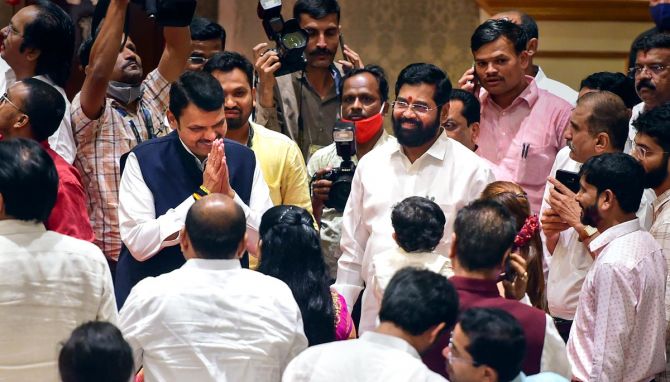'How can the EC then deduce that 76 per cent of the people who voted for the united Shiv Sena's MLAs voted for Eknath Shinde?'

Constitutional expert and former secretary general of the Lok Sabha P D T Achary tells Prasanna D Zore/Rediff.com that though the Election Commission had a precedence in the Sadiq Ali case of 1969 which ruled in favour of Indira Gandhi and which was later also upheld by the Supreme Court of India, the EC's calculation of percentages to decide in favour of the Eknath Shinde faction of the Shiv Sena is tricky.
What mistakes cost Uddhav Thackeray the party symbol as well as the party name?
The Election Commission certainly has the power to decide this issue as per the Symbols Order wherein they go by the number of MPs, the number of MLAs, and on the party side, the number of important office bearers the Shinde and Uddhav faction had support of.
So, the EC has decided the issue only all the basis of these (numbers). That is the basis on which the EC made its decision. And this decision was based on the landmark Sadiq Ali case of 1969 (external link) that revolved around the split in the Congress party.
In the Sadiq Ali case the EC had devised a formula to decide which faction was the real Congress.
While deciding the Uddhav versus Shinde fight about who owns the real Shiv Sena and to who should the original bow and arrow symbol of the Shiv Sena should go the (EC's) formula was based on how many MPs and MLAs supported which faction of the Congress (in 1969) -- including the important office bearers along the party's entire organisational hierarchy.
On the basis of this, the EC in 1969 decided that the real Congress was the one led by Indira Gandhi. The same criterion was applied to decide in this case also.
The EC must have gone into the Sadiq Ali case and so there they have some precedence.
They must have counted how many elected MPs and MLAs are with Shinde and Thackeray.
According to newspaper reports the EC weighed in that the MLAs in the Shinde faction garnered 76 per cent votes out of the total 4,782,440 votes polled by the 55 victorious MLAs of the united Shiv Sena in the 2019 assembly election.
How do you know that these votes came only from the people who supported the Shiv Sena? Some of these votes could have also come from the BJP with whom they had a pre-poll alliance for the 2019 elections.
How far is this figure then reliable as a barometer of votes polled by the victorious Shiv Sena MLAs or MPs belonging to the two factions?
When there is an alliance it is really very tricky to find out what number of votes you got from those supporting your party and what number came from those who are basically supporters of your ally. Or, how many people from the other parties voted for you.
It is impossible to measure these numbers and so (it is) not very reliable way of measuring support for a particular faction.
What legal options does the Uddhav Thackeray camp now have?
He will definitely go in appeal against the EC's decision in the Supreme Court and the final say will have to be the Supreme Court's on this issue.
However, the decision taken by the EC in the Sadiq Ali case was endorsed by the Supreme Court. The Supreme Court then had said that the formula devised by the EC was rational and so the Supreme Court upheld the decision of the Election Commission.
But the figure that the Election Commission has taken into account (while deciding the Shinde versus Thackeray matter) is not a reliable barometer of support for the two factions because when the elections were held in 2019 the Shiv Sena was together and not split into two different factions.
So, how will one know that when elections were held in 2019 how many people actually voted for Uddhav Thackeray or Eknath Shinde.
How can the EC then deduce that 76 per cent of the people who actually voted the united Shiv Sena's MLAs voted for Eknath Shinde? Unless the EC has some kind of a secret formula it is difficult to calculate these percentages.
When the Maharashtra assembly elections happened in 2019 all the people who voted for the victory of these 55 MLAs voted for the united Shiv Sena and not for the two factions that emerged after June 2022.
After the split you cannot say that all those 76 per cent voters would have voted for Eknath Shinde only. That's very irrational.
Is this issue settled forever?
There is no finality. Naturally, the party against which the EC decision was made can go in appeal in the Supreme Court and the decision of the apex court will be the final decision.
How the EC decided upon the rational to support the arguments put forth by the Shinde camp can be challenged in the SC. But the formula to arrive at the percentage is definitely a tricky issue.










